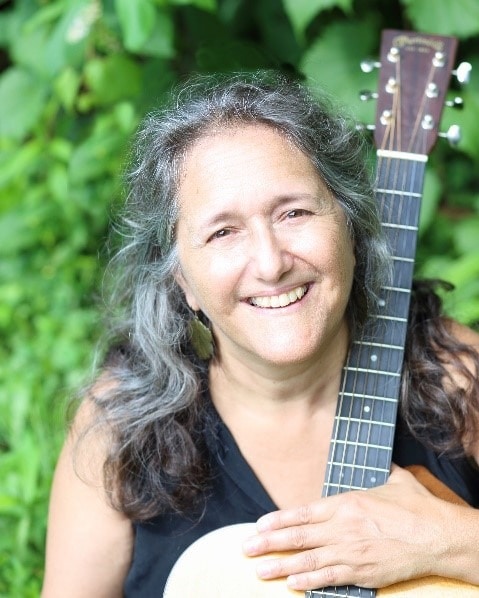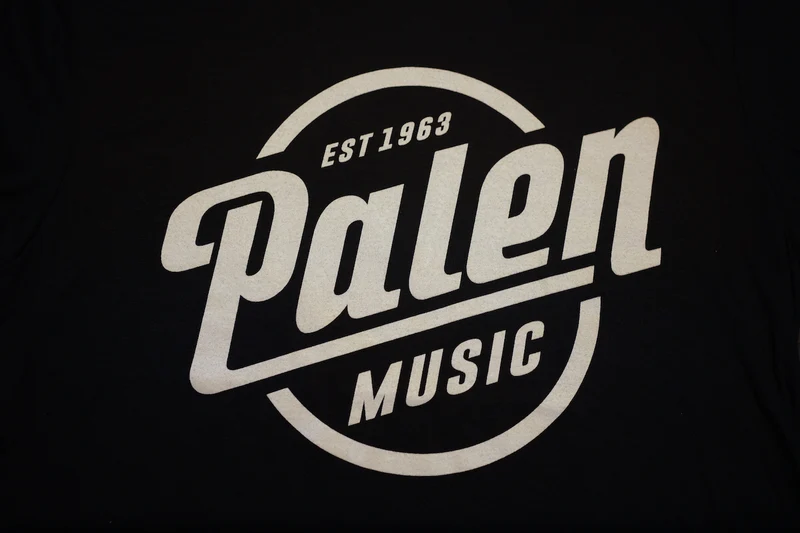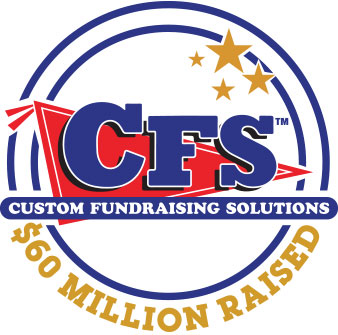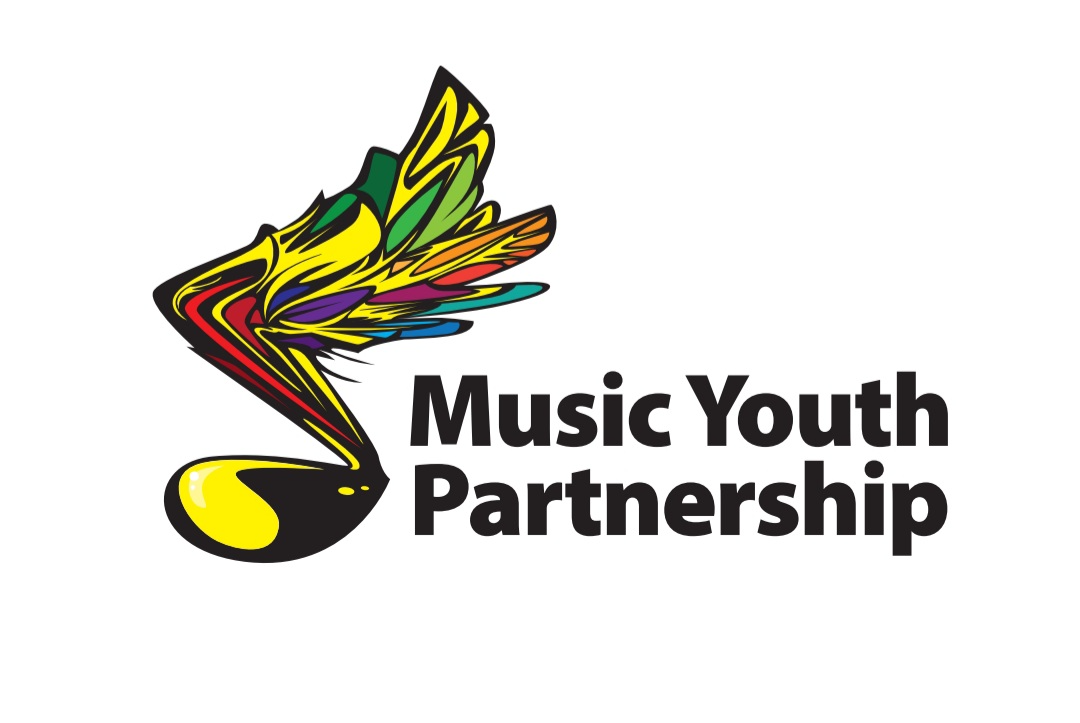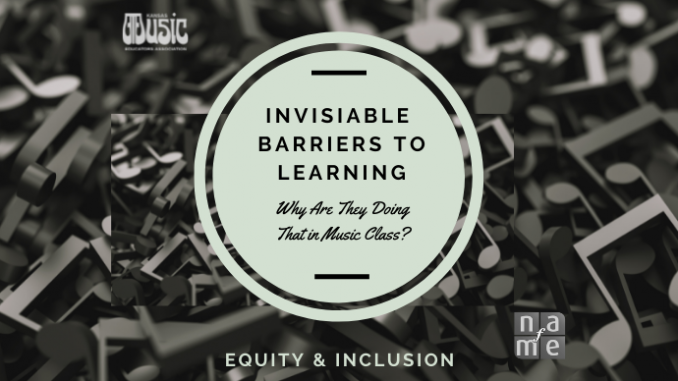
Why Are They Doing That in Music Class?
By NAfME Member Joanie Calem
Reprinted with permission from NAfME’s Music in a Minuet Blog
Joanie Calem presented on “Equity and Inclusion—Invisible Barriers to Learning” during the NAfME 2021 PreK–12 Learning Collaborative in February 2021.
Like many of us, I simultaneously wear a number of different hats that inform my daily life: I am a private and a classroom music teacher, I am a performing and recording musician, I am a mother and spouse, and I present about Equity and Inclusion—Invisible Barriers to Learning in numerous conference settings. And as a mother, I also wear two hats, one as the parent of a neuro-typical artsy type daughter and one as the parent of a neuro-divergent artsy type son with autism.
My son was my first introduction to Sensory Processing Disorder (SPD), as most people with autism also have SPD. Having taken a deep dive in educating myself about this phenomenon, I discovered not only how to help my son, but also how to help many of my students who had unusual behavior at seemingly erratic times of day but were not diagnosed with any kind of learning disability. All of this led me to understanding more about the invisible barriers to learning that so many of our students grapple with.
In addition to making sure that the content, intent, and lyrics of the musical material that we share with our students is musical, educational, and inclusive of all, we also need to make sure that our programs are sensory-friendly.
Sensory Processing Difficulties, ACES, and Equity
Our senses provide us with input that helps us organize and understand our world. Sensory Processing Disorder, or SPD, is a neurological phenomenon that affects how our senses process incoming input. When we cannot efficiently process input from one or several of our senses, our feeling of wellbeing is negatively affected, and we often get overwhelmed. When we are overwhelmed, we are not understanding what is going on, and we instinctively look for a way to cope with the situation. Some students cope with being overwhelmed by having loud, disruptive outbursts, while others simply shut down and zone out. A 2009 study reported that 1 in 6 people have SPD.
Adverse Childhood Experiences, or ACEs, affect children’s developing brains. (A new study uses the same acronym for Adverse Community Environments.) Too many ACEs (four or more) that go unsupported and unresolved can reshape the neurology of children’s brains and how children respond to stress, and therefore directly affect their school and life experiences. Unfortunately, ACEs are common. A 2019 CDC bulletin found that nearly 1 in 6 people reported they had experienced four or more types of ACEs. ACES often present as Sensory Overload in school settings.
Equity is generally defined as “the state, quality or ideal of being just, impartial and fair.”
For most of us, understanding how equity relates to students of different racial and socio-economic backgrounds is fairly clear, or at least the need for equity in those areas is visibly on the table. Obviously, equity in music education is far from being fully resolved, but we are aware of the issue, and we are working consciously to provide equity.
But equity also relates to learning styles and sensory issues. A student with auditory sensory processing disorder in a music class may really struggle to access the musical experience that we are attempting to provide because they are overloading from the auditory input. Asking that child to function calmly in an auditory setting that might be actually painful for them is not exactly fair or equitable.
More and more social workers and psychologists are beginning to understand the effects of ACEs on our student population. Fewer people are aware of the connection between ACEs and SPD. And even fewer people are looking at this through the lens of equity.
So, I invite us, as music educators, concerned with our students social-emotional health, eager to share our love of the magic healing that music provides, happy to build both robust musical experiences and healthy music classroom communities, to start to consider how we accommodate students with sensory overload. They might not come with an IEP or a documented diagnosis. (The CDC 2020 report on autism puts the numbers at 1 in 54 children, while 1 in 6 children have SPD or ACEs.) They might not be able to explain what is hard for them. They might clearly love music making but not be able to follow instructions. They might want to explore and improvise but struggle with structured learning. They might have one of these sensory responses:
(Sadly, the length of a blog doesn’t allow for a full explanation of the intricacy of SPD and ACES . . . for that you have to have me come do a workshop!)

Many of you have likely come across the first four lines of this quote that has been making its way around the sites of people concerned with inclusion and community-building. I added the last line regarding equity.
- Accessibility is being able to get in the building.
- Diversity is getting invited to the table.
- Inclusion is having a voice at the table.
- Belonging is having your voice respected at the table.
- Equity is having the builders of the table understand and make accommodations for the fact that not everyone comes to the table in the same way, and once everyone is sitting around the table, not everyone can respond in the same way.
We don’t all come to life and to music class with the same sensory wiring. This is just one more piece to the puzzle of how children access music, and a possible explanation to Why Are They Doing That in Music Class? Behavior is communication, and we as teachers are the detectives commissioned with figuring out what our students are trying to communicate to us. We should not expect ourselves to be able to solve everything for every child, but being aware that these invisible factors exist will go a long way to maintaining more equitable, inclusive classrooms.
Oh, and by the way, living through a worldwide pandemic counts as an ACE . . . so we all have one more to add to the list . . .
Resources:
ACES: How Childhood Trauma Affects Health Across a Lifetime: Burke Harris, Dr. Nadine
Bullying Is an Adverse Childhood Experience, Urbanski J
Data and Statistics on Autism Spectrum Disorder
Eye Contact Is WAY Overrated, A Sensory Life
For Some Kids, This Last Year Qualifies as an Adverse Childhood Experience (ACE), Campbell, Leah
How Family Background Influences Student Achievement, Egalite, Anna J.
The Impact of Adverse and Protective Childhood Experiences
In the COVID Era: Stabilizing and Strengthening Young Children and Their Families, Haas, Becky
The Out of Sync Child, by Stock Kranowitz, Carol, M.A.
Positive Childhood Experiences
Post-Traumatic Stress Disorder in Children, Children’s Hospital of Philadelphia
Preventing ACES: Leveraging the Best Available Evidence, CDC
Sensory Differences, The National (U.K.) Autism Society
Sensory Processing in Autism, Autism Spectrum Australia
Seven Early Experiences with Potential Benefits in Adulthood
Tactile, Vestibular and Proprioceptive Senses, Sawers, Cherrington
Teaching the Children of the Opioid Crisis, Litvinov, Amanda
About the author:
NAfME member Joanie Calem is a parent, music teacher, songwriter, performer, and inclusion advocate. Joanie has been a music teacher since 1983, teaching music in every possible modality in order to reach all of her students and allow them to access music in whatever learning style suits them best. She has a BA in Music in Community Building from DePaul University, and invites her classes and audiences, young and old, on an adventure of community building with interactive songs and stories, sharing successful strategies to create classrooms and communities that work for everyone. As the parent of a young adult with autism, Joanie wears two hats simultaneously: that of being an educator in inclusive classrooms, and that of being an advocate for her own son. Joanie has extensive learning in the field of Sensory Processing Disorder and shares her years of experience through “concert-conversations” for teachers, parents, and communities, using her original songs as starting points for discussions on how to build truly inclusive communities that allow room for the increasing “neurodiversity” in our world.


